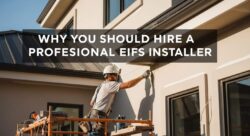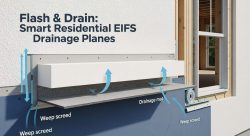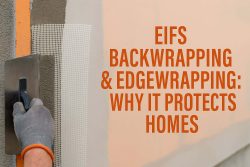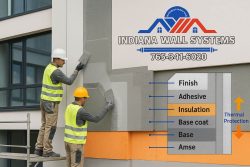Flawless EIFS Begins Before the Finish – Protect Your Investment With Expert Substrate Prep
When it comes to EIFS installation, most people focus on the final finish coat. They get excited about color choices and textures. But let me tell you something after 22 years in this business – the substrate preparation is where EIFS projects either succeed or fail.
I’m Jeff Johnson from Indiana Wall Systems, and I’ve seen countless EIFS failures that could have been prevented with proper substrate prep. Today, we’re diving deep into why substrate prep matters and how it affects everything from adhesion strength to long-term performance.
Key Takeaways
- Proper substrate preparation prevents 80% of EIFS failures
- Moisture content testing is crucial before any installation begins
- Surface profiling and leveling ensure optimal adhesion strength
- Quality substrate prep can extend EIFS lifespan by 15-20 years
- Professional preparation saves thousands in future repair costs
Understanding Why Substrate Prep Matters
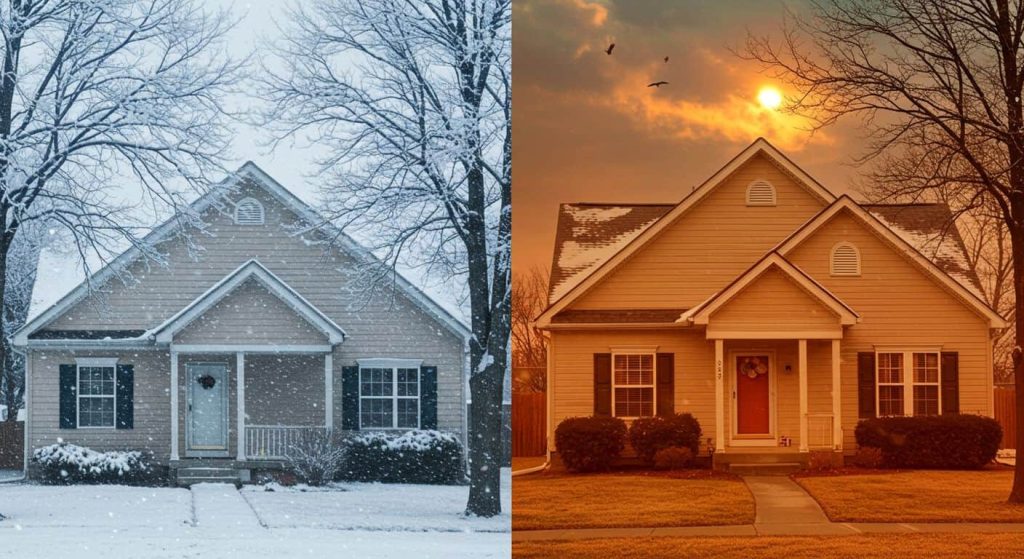
Preparing the substrate isn’t just a recommended step – it’s the foundation of your entire EIFS system. Think of it like building a house. You wouldn’t put up walls on a cracked, uneven foundation, would you?
The substrate is the surface that your EIFS attaches to. This could be OSB sheathing, gypsum sheathing, structural sheathing, or even existing masonry. Each material has different requirements and challenges.
Substrate integrity directly impacts:
- Base coat adhesion
- Mesh embedment quality
- System durability
- Energy efficiency performance
- Moisture resistance
When substrate prep is rushed or skipped, you’re setting up for delamination or detachment. I’ve seen systems fail within just a few years because contractors took shortcuts during this critical phase.
The Hidden Costs of Poor Preparation
Let’s talk numbers for a minute. Proper installation might cost 15-20% more upfront due to thorough substrate prep. But improperly prepared substrates can lead to:
- Complete system replacement ($8,000-$15,000 for average homes)
- Moisture intrusion and damage to framing
- Structural damage requiring major repairs
- Decreased resale value and longevity
- Voided manufacturer warranties
💰 Substrate Prep Cost vs. Failure Cost Calculator
Pro tip: Every dollar spent on quality substrate prep saves you three to five dollars in future repairs.
Key Aspects of Professional Substrate Preparation
Cleaning the Surface
Cleaning the surface is step one, but it’s more complex than it sounds. We’re not just removing dirt and debris.
Dust removal is critical because even microscopic particles can interfere with adhesion. We use specialized equipment for:
- Pressure washing when appropriate
- Degreasing agents for oil stains
- Rust removal from metal surfaces
- Efflorescence control on masonry
- Chalking removal from painted surfaces
Each cleaning method depends on your substrate type and site conditions. What works for gypsum sheathing won’t work for concrete masonry.
Repairing Any Damage
Before applying any EIFS components, we address surface damage. This includes:
- Filling gaps and holes
- Replacing damaged sheathing sections
- Reinforcing loose areas
- Sealing penetrations around utilities
- Treating rust or corrosion
Small issues become big problems fast in EIFS systems. A tiny gap can channel water behind your system, leading to moisture intrusion and damage.
Ensuring the Substrate is Dry
Moisture content testing isn’t optional – it’s mandatory for quality work. We use pinless moisture meters and sometimes infrared scan technology to verify dryness.
Acceptable tolerance varies by material:
- Wood sheathing: Under 19% moisture content
- Concrete/masonry: Under 6% moisture content
- Gypsum board: Under 12% moisture content
📊 Acceptable Moisture Content by Substrate Type
⚠️ Installing EIFS over wet substrates voids warranties and guarantees failure
Installing EIFS over wet substrates void warranties and guarantee failure. Always check moisture levels, especially after weather exposure.
Installing a Water-Resistant Barrier
Modern EIFS requires a water-resistant barrier behind the system. This vapor barrier prevents moisture from reaching your structural components.
Different materials require different barrier types:
- House wrap for wood sheathing
- Specialized membranes for masonry
- Vapor-permeable barriers for continuous insulation systems
The barrier must create a complete building envelope without gaps or tears. Lap joints need proper sealing, and all penetrations must be sealed correctly.
Proper Installation Techniques
Workmanship standards for barrier installation include:
- Minimum 6-inch overlaps at joints
- Proper fastener spacing (per manufacturer specifications)
- Sealed penetrations
- Continuous coverage from roof to foundation
One of the most common mistakes is inadequate sealing around windows and doors. These areas need extra attention because they’re prime spots for water intrusion.
Leveling the Surface
Substrate evenness directly affects your final finish quality. Substrate movement and settling can create uneven surfaces that show through the finish coat.
Surface profiling requirements:
- Maximum 1/4-inch variation per 10 feet
- Smooth transitions between materials
- Proper slope for water drainage
- Consistent thickness for basecoat application
We use specialized tools for leveling the surface:
- Long straightedges for checking flatness
- Laser levels for large areas
- Bonding agent for smoothing minor irregularities
Substrate Compatibility Issues
Not all substrates work well together. Thermal expansion rates vary between building materials. Steel expands differently than wood, which expands differently than concrete.
Expansion joints become crucial when dealing with different materials. These joints accommodate movement from temperature changes and prevent cracking.
Temperature swings in Indiana can be dramatic. Materials expand and contract significantly, and your substrate prep must account for this movement.
Professional Tools and Testing Methods
Specialized knowledge and expertise shows in the tools we use. Professional substrate prep requires more than basic construction tools.
Essential Testing Equipment
Quality assurance depends on proper testing:
- Pinless moisture meters for non-invasive moisture detection
- pH testing kits for masonry surfaces
- Pull-test equipment for adhesion strength verification
- Infrared scan devices for thermal imaging
- Surface profile gauges for texture measurement
Inspector approval often requires documented test results. We maintain detailed records of all substrate conditions and prep work.
Professional Application Techniques
Primer application varies by substrate type. Gypsum sheathing needs different treatment than OSB sheathing.
Curing time affects everything. Rushing the drying process leads to poor adhesion and system failure. Weather exposure during prep can ruin hours of work.
Site conditions matter enormously. Humidity, temperature, and wind all affect substrate preparation. We monitor conditions constantly and adjust our methods accordingly.
Common Substrate Preparation Mistakes
Skipping Moisture Testing
Surprisingly common mistake: assuming substrates are dry without testing. Trapped moisture will cause delamination within months.
Always check moisture levels, even if the substrate looks dry. Appearances deceive, especially with humidity and temperature changes.
Inadequate Surface Cleaning
Surface contamination prevents proper adhesion. Oil, dirt, release agents, and old paint all interfere with bonding.
Knowing what to look for takes experience. Some contaminants aren’t visible but still cause damage to the system.
Poor Joint Treatment
Control joints and expansion joints need special attention. These areas allow water to penetrate if not properly sealed.
Joint treatment involves:
- Proper sealant selection
- Correct application techniques
- Regular maintenance schedules
- Understanding movement patterns
Inadequate Drainage Planning
Water must have somewhere to go. Prevent water accumulation by ensuring proper drainage around the perimeter.
Weep holes and drainage systems protect your substrate from water damage. Without them, even perfect prep work won’t prevent costly problems.
The Role of Professional Installation
Why should you hire a professional for substrate prep? Because specialized knowledge and expertise makes the difference between success and failure.
At Indiana Wall Systems, we’ve completed thousands of EIFS installations across Indiana. Our 22 years of experience taught us that substrate prep determines project success.
Our Substrate Preparation Process
Our step-by-step process ensures quality assurance:
- Inspection and documentation of existing conditions
- Moisture content testing and documentation
- Surface cleaning appropriate to substrate type
- Damage repair and surface preparation
- Water-resistant barrier installation
- Final inspection before EIFS application
✅ Professional Substrate Prep Checklist
Each step follows manufacturer specifications and industry standards. We don’t take shortcuts because shortcuts lead to callbacks and unhappy customers.
Working with Building Codes
Building envelope requirements continue evolving. Modern codes emphasize energy efficiency and moisture management.
Our team stays current with building codes and manufacturer specifications. We ensure your project meets all requirements and passes inspection.
Trades coordination is crucial for substrate prep. Electrical, plumbing, and HVAC penetrations must be planned and sealed properly.
Substrate Types and Their Unique Requirements
Wood Sheathing Systems
OSB sheathing and plywood require specific preparation techniques:
- Moisture content must be under 19%
- All edges and penetrations need sealing
- Structural integrity verification
- Proper fastener spacing and penetration
🌡️ Indiana Climate Impact on EIFS Substrate
❄️ Winter Challenges
- Freeze-thaw cycles
- Substrate contraction
- Moisture freezing
- Brittle material behavior
☀️ Summer Challenges
- Thermal expansion
- High humidity (80%+)
- UV degradation
- Rapid moisture changes
Structural sheathing provides the strength for your wall system. Any compromise in the sheathing compromises your entire EIFS system.
Masonry Substrates
Masonry surfaces present unique challenges:
- pH testing to ensure compatibility
- Efflorescence control treatment
- Surface texture requirements
- Thermal bridging considerations
Cavity walls need special attention to drainage and vapor management. Water away from the structure through proper weep holes and flashing.
Steel and Concrete Substrates
Metal and concrete substrates require:
- Rust removal and treatment
- Primer application for adhesion
- Thermal expansion joint planning
- Corrosion protection measures
Temperature changes affect metal substrates dramatically. Expansion anchors and flexible connections accommodate this movement.
🔧 Substrate Compatibility & Requirements Matrix
| Substrate Type | Max Moisture | Special Prep | Primer Required | Difficulty |
|---|---|---|---|---|
| OSB Sheathing | < 19% | Edge sealing | ✅ | MEDIUM |
| Gypsum Sheathing | < 12% | Joint treatment | ✅ | EASY |
| Concrete/Masonry | < 6% | pH testing | ✅ | HARD |
| Steel/Metal | 0% | Rust removal | ✅✅ | HARD |
Quality Assurance and Long-Term Performance
Preventative maintenance starts with proper substrate prep. When done correctly, substrate preparation provides peace of mind for decades.
Documentation and Warranties
Professional substrate prep includes:
- Complete photographic documentation
- Moisture content test results
- Material compatibility certifications
- Manufacturer specifications compliance verification
This documentation protects your investment and ensures warranty coverage.
Long-Term Performance Benefits
Proper installation with quality substrate prep delivers:
- Energy efficiency improvements
- Durability for 20+ years
- Thermal performance optimization
- Structural integrity maintenance
- Reduced maintenance costs
Multi-layer system performance depends entirely on substrate preparation quality. Each layer builds on the previous one.
Regional Considerations for Indiana
Indiana’s climate presents specific challenges for EIFS substrate preparation:
Weather Patterns
Temperature swings from -10°F to 95°F stress building materials. Freeze-thaw cycles can damage improperly prepared substrates.
Humidity levels vary dramatically between seasons. Summer humidity can exceed 80%, while winter air becomes extremely dry.
Local Building Practices
Indiana building practices evolved to handle our climate challenges. Continuous insulation helps with thermal bridging issues common in our region.
Local building codes address these regional challenges. Our team understands Indiana-specific requirements and best practices.
The Bottom Line: Investment in Quality
Substrate preparation costs represent about 15-20% of total EIFS installation costs. This investment pays for itself through:
- Extended system lifespan
- Reduced maintenance costs
- Energy savings
- Higher resale value
- Peace of mind
Poor substrate prep creates problems that compound over time. Water absorption, thermal bridging, and adhesion failure all trace back to inadequate preparation.
Working with Indiana Wall Systems
Our approach to substrate preparation reflects our commitment to quality. We don’t rush this critical phase because we know shortcuts lead to problems.
22 years of experience taught us that substrate prep separates professional contractors from amateurs. Our detailed preparation process ensures long-term performance and customer satisfaction.
Specialized knowledge and expertise in substrate preparation comes from thousands of successful installations. We’ve seen what works and what doesn’t in Indiana’s challenging climate.
For EIFS installation in Carmel, Fishers, Zionsville, and throughout central Indiana, proper substrate preparation ensures your investment lasts for decades.
Frequently Asked Questions
How long should substrate preparation take?
Proper substrate preparation typically takes 2-3 days for average residential projects. This includes moisture testing, cleaning, repairs, and barrier installation. Rushing this process increases failure risk significantly.
Can I prepare the substrate myself?
DIY substrate preparation poses serious risks including warranty voiding, adhesion failure, and moisture problems. Professional preparation requires specialized tools, knowledge, and experience to ensure proper results.
What moisture levels are acceptable for EIFS installation?
Acceptable moisture levels vary by substrate material: wood sheathing under 19%, concrete/masonry under 6%, and gypsum board under 12%. Testing must be done with calibrated instruments.
How do temperature changes affect substrate preparation?
Temperature changes cause materials to expand and contract, affecting adhesion and system integrity. Proper preparation includes expansion joints and flexible connections to accommodate this movement safely.
What happens if substrate prep is skipped?
Skipping substrate preparation leads to adhesion failure, moisture intrusion, delamination, and premature system failure. These problems often void warranties and require expensive repairs or complete replacement.
How often should prepared substrates be inspected?
Prepared substrates should be inspected immediately before EIFS application and after any weather exposure. Rain, wind, or temperature extremes may require additional preparation steps or re-cleaning.
Professional substrate preparation forms the foundation of every successful EIFS installation. Don’t let poor prep work undermine your investment. Contact Indiana Wall Systems at (765) 341-6020 for expert substrate preparation and professional EIFS installation that lasts.
Trust the experts who understand that the unsung hero of smooth EIFS installs is always proper substrate preparation.

